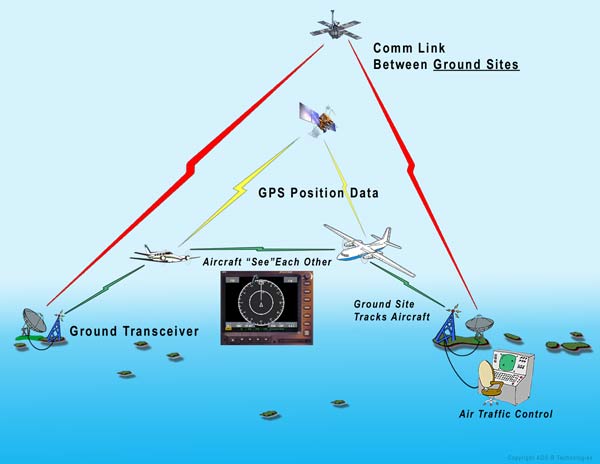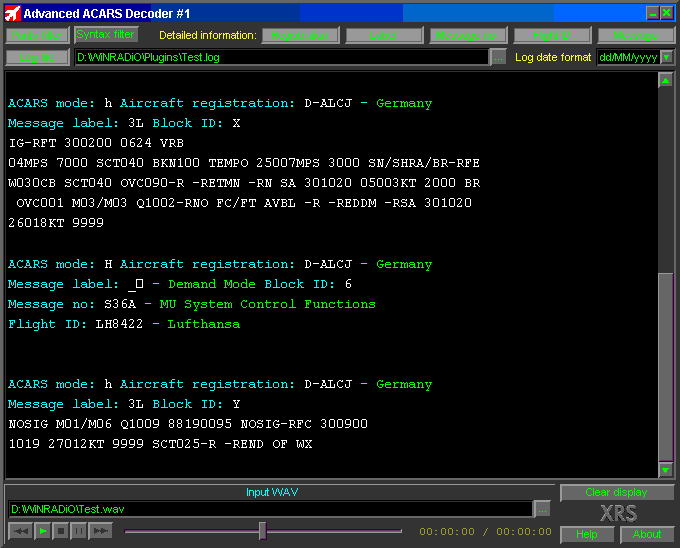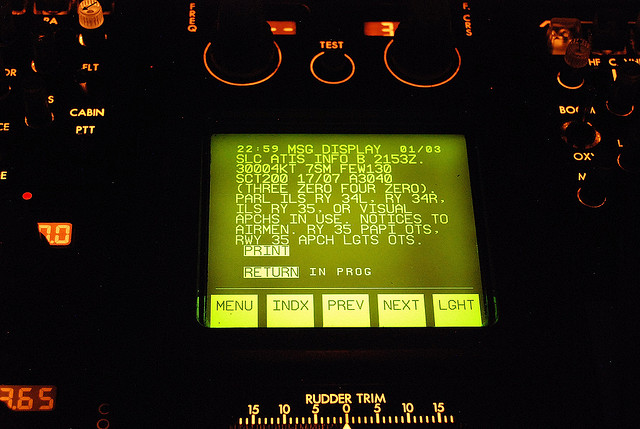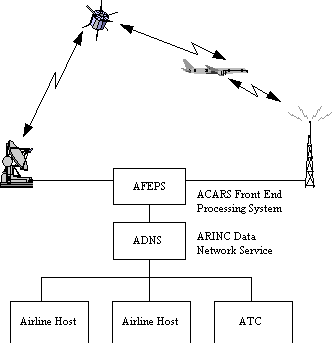|
MODE-S is
a Secondary Surveillance Radar technique that permits selective
interrogation of aircraft by means of a unique 24-bit aircraft
address, thus avoiding the risk of confusion or mis-identification
due to overlapping signals.
Mode S has been standardised by ICAO for many
years. It employs ground-based interrogators and airborne
transponders and operates in the same radio frequencies (1030/1090
MHz) as conventional SSR systems with which it is backwards
compatible.
Mode S has been deployed because the historical
SSR systems have reached the limit of their operational capability.
This takes the form of exceeded maximum number of targets, RF
pollution, lost targets, identity errors and Mode A code shortage.
Mode S is therefore a necessary SSR replacement in airspace subject
to high levels of traffic density and will form part of the basis of
the Surveillance infrastructure for much of the first quarter of the
21st Century.
There are five sources of RF pollution:
- Acquisition
Squitter
- Extended
Squitter
-
ACAS transactions
-
Self-generated Second Time Around Replies
- Replies
from other Radar Interrogations
Mode-S employs airborne transponders to provide
altitude and identification data, with ADS-B adding global
navigation data typically obtained from a GPS receiver.
The position and identification data supplied by Mode S/ADS-B broadcasts
are available to pilots and air traffic controllers.
Mode S/ADS-B data updates rapidly, is very
accurate and provides pilots and air traffic controllers with common
air situational awareness for enhanced safety, capacity and
efficiency. Further, It can provide a cost-effective solution for
surveillance coverage in non-radar airspace.
In Europe, SSR Mode S is being implemented in two
stages: Mode S Elementary Surveillance (ELS) and Mode S Enhanced
Surveillance (EHS).
ADS-B is a system in which electronic
equipment onboard an aircraft automatically broadcasts the precise
location of the aircraft via a digital data link.
The data can be used by other aircraft and air
traffic control to show the aircraft’s position and altitude on
display screens without the need for radar.
The system involves an aircraft with ADS-B
determining its position using GPS. A suitable transmitter then
broadcasts that position at rapid intervals, along with identity,
altitude, velocity and other data. Dedicated ADS-B grounds stations
receive the broadcasts and relay the information to air traffic
control for precise tracking of the aircraft.
Automatic – Requires no pilot input or external
interrogation.
Dependant – Depends on accurate position and velocity data
from the aircraft’s navigation system (eg. GPS).
Surveillance – Provides aircraft position, altitude,
velocity, and other surveillance data to facilities that require the
information.
Broadcast – Information is continually broadcast for
monitoring by appropriately equipped ground stations or aircraft.
ADS-B data is broadcast every half-second on a
1090MHz, digital data link.
Broadcasts may include:
-
Flight Identification
(flight number callsign or call sign)
-
ICAO 24-bit Aircraft Address (globally unique
airframe code)
-
Position (latitude/longitude)
-
Position integrity/accuracy (GPS horizontal
protection limit)
-
Barometric and Geometric Altitudes
-
Vertical Rate (rate of climb/descent)
-
Track Angle and Ground Speed (velocity)
-
Emergency indication (when emergency code
selected)
Special position identification (when IDENT
selected)
The ability of a ground station to receive a
signal depends on altitude, distance from the site and obstructing
terrain. The maximum range of each ground station can exceed 250
nautical miles. In airspace immediately surrounding each ground
station, surveillance coverage extends to near the surface.

For further information on
Radar techniques and hardware equipments, follow these links:
http://www.radartutorial.eu/index.en.html
http://www.modesbeast.com/ |
Aircraft Communications Addressing and
Reporting System (ACARS)
is a digital datalink system for transmission of short,
relatively simple messages between aircraft and ground stations
via radio or satellite.
The protocol, which was designed by Aeronautical Radio, Incorporated
(ARINC)
to replace their very high frequency (VHF) voice service and
deployed in 1978 uses telex formats. SITA later
augmented their worldwide ground data network by adding radio
stations to provide ACARS service.
Over the next 20 years, ACARS will be superseded by the Aeronautical
Telecommunications Network (ATN)
protocol for Air Traffic Control communications and by the Internet
Protocol for airline communications.
 Maintenance
data download Maintenance
data download
The introduction
of the interface in the early 1990s between the FDAMS / ACMS systems
and the ACARS MU, resulted in datalink's gaining wider acceptance by
airlines. The FDAMS / ACMS systems which analyze engine aircraft,
and operational performance conditions were now able to provide
performance data to the airlines on the ground in real time using
the ACARS network. This reduced the need for airline personnel to go
to the aircraft to off-load the data from these systems. These
systems were capable of identifying abnormal flight conditions and
automatically sending real-time messages to an airline. Detailed
engine reports could also be transmitted to the ground via ACARS.
The airlines used these reports to automate engine trending
activities. This capability enabled airlines to monitor their engine
performance more accurately and identify and plan repair and
maintenance their activities more rapidly.
In addition to
the FMS and FDAMS interfaces, the industry started to upgrade the
on-board maintenance computers in the 1990s to support the
transmission of maintenance-related information in real-time through
ACARS. This enabled airline maintenance personnel to receive
real-time data associated with maintenance faults on the aircraft.
When coupled with the FDAMS data, airline maintenance personnel
could now start planning repair and maintenance activities while the
aircraft was still in flight.
Interactive
crew interface
All of the
processing described above is performed automatically by the ACARS
MU and other associated avionics systems, without flight crew
intervention. As part of the growth of ACARS functionality, the
ACARS MUs also interfaced directly with a control display unit
(CDU), located in the cockpit.
This CDU, often referred to as an MCDU or MIDU, provides the flight
crew with the ability to send and receive messages similar to
today’s email. To facilitate this communication, the airlines in
partnership with their ACARS vendor defined MCDU screens that could
be presented to the flight crew and enable them to perform specific
functions. This feature provides the flight crew flexibility as to
the types of information requested from the ground and the types of
reports sent to the ground. ACARS
MU and other associated avionics systems, without flight crew
intervention. As part of the growth of ACARS functionality, the
ACARS MUs also interfaced directly with a control display unit
(CDU), located in the cockpit.
This CDU, often referred to as an MCDU or MIDU, provides the flight
crew with the ability to send and receive messages similar to
today’s email. To facilitate this communication, the airlines in
partnership with their ACARS vendor defined MCDU screens that could
be presented to the flight crew and enable them to perform specific
functions. This feature provides the flight crew flexibility as to
the types of information requested from the ground and the types of
reports sent to the ground.
As an example,
the flight crew could pull up an MCDU screen that allowed them to
send to the ground a request for various types of weather
information. After the desired locations and type of weather
information were entered, ACARS transmitted this information to the
ground. In response to this request message, ground computers sent
the requested weather information back to the ACARS MU, which was
then displayed and/or printed.
Airlines began
adding new messages to support new applications (weather, winds,
clearances, connecting flights, etc.) and ACARS systems were
customized to support airline-unique applications, and unique ground
computer requirements. This resulted in each airline having its own
unique ACARS application operating on its aircraft. Some airlines
have more than 75 MCDU screens for their flight crews, where other
may have only a dozen different screens. In addition, since each
airline’s ground computers were different, the contents and formats
of the messages sent by an ACARS MU were different for each airline.
 |

